1型Crisponi/冷致出汗综合征患者的牙科治疗1例报告。
IF 0.5
4区 医学
Q4 GENETICS & HEREDITY
引用次数: 0
摘要
本文章由计算机程序翻译,如有差异,请以英文原文为准。
Dental management in a patient with Crisponi/cold-induced sweating syndrome type 1: a case report.
Introduction In this case, extensive dental caries and restricted mouth opening were identified in a 9-year-old Turkish girl with Crisponi/cold-induced sweating syndrome type 1 (CS/ CISS1) who had hyperthermia, facial muscle contractions, and camptodactyly. Oral rehabilitation, including preventive and restorative treatment procedures, was applied. This report shows that puree feeding, decreased motor function, and lack of oral hygiene stand out as a factor in forming dental caries in CS/CISS1.
求助全文
通过发布文献求助,成功后即可免费获取论文全文。
去求助
来源期刊

Clinical Dysmorphology
医学-遗传学
CiteScore
1.20
自引率
0.00%
发文量
64
审稿时长
6-12 weeks
期刊介绍:
Clinical Dysmorphology publishes succinct case reports on the etiology, clinical delineation, genetic mapping, and molecular embryology of birth defects. This journal covers such topics as multiple congenital anomaly syndromes - with particular emphasis on previously undescribed conditions, rare findings, ethnic differences in existing syndromes, fetal abnormalities, and cytogenetic aberrations that might give clues to the localization of developmental genes. Regular features include original, peer-reviewed articles, conference reports, book and software reviews, abstracts and summaries from the UK Dysmorphology Club, and literature summaries.
Submitted articles undergo a preliminary review by the editor. Some articles may be returned to authors wihtout further consideration. Those being considered for publication will undergo further assessment and peer-review by the editors and those invited to do so from a reviewer pool.
 求助内容:
求助内容: 应助结果提醒方式:
应助结果提醒方式:


